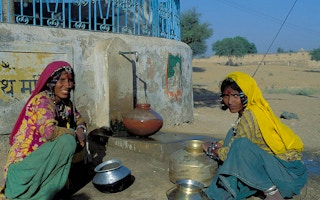Using machine learning, researchers have developed a technique to ensure sufficient ‘free residual chlorine’ in drinking water to destroy bacteria and viruses responsible for infectious disease outbreaks in refugee camps and settlements.
According to the US Centers for Disease Control and Prevention (CDC), the amount of free residual chlorine available to kill germs is a measure of how safe water is to drink. A free chlorine level of 0.5 milligrams per litre is enough to maintain the quality of water through piped distribution networks, but insufficient to maintain the quality of the water stored in a bucket for 24 hours.
Machine learning, which uses artificial intelligence based on historical data to develop software applications capable of forecasting outcomes, can help predict whether enough chlorine will remain in stored water to keep it drinkable, the researchers say.
“Our tool uses machine learning to predict chlorine decay in refugee or internally displaced person (IDP) settlements after water leaves the distribution system,” says Michael De Santi, a researcher affiliated with the Canada-based York University‘s Lassonde School of Engineering and an author of the findings of a study in PLOS Water.
“This is important because chlorine protects water from pathogens when water is collected, transported to the dwelling, stored, and used — we want to make sure that there is enough of it to prevent pathogens from spreading,” he tells SciDev.Net.
“
This model will help to correctly estimate and predict point-of-consumption free residual chlorine to kill pathogens. However, more studies are needed in this direction.
Chiranjib Chakraborty, professor, Adamas University
According to the study, people in refugee settlements typically do not receive piped drinking water but depend on water drawn from public taps and stored in containers. The process increases the possibility of re-contaminating the water, leading to outbreaks of diseases like cholera, shigella infection and hepatitis E in refugee camps and settlements.
“To prevent outbreaks in refugee and IDP settlements, drinking water needs to be protected against pathogenic recontamination until the end of the household storage period when the final cup is consumed,” the researchers say.
For the study, the researchers made use of standard water quality monitoring data from two refugee settlements, one in Bangladesh and the other in Tanzania.
In Bangladesh, 2,130 samples were collected during June to December 2019 and machine learning was applied to forecast the probability of adequate chlorine persisting in the water until it was used up by the refugees.
Water system operators then deployed an artificial neural network — a computational model resembling the work of nerve cells in the brain — together with forecasting systems routinely used in making weather forecasts. The researchers said that forecasts could be made at the point of intake of stored water in refugee camps taking into consideration various factors like local temperature, water quality, and the condition of waterpipes.
Santi explained that the machine learning model relies on “probabilistic forecasting”, which means the model is capable of predicting the full range of likely chlorine concentrations and their associated probabilities. He added that the advantage of providing a probability rather than a single value is that it helps water system operators select an optimised chlorination strategy.
Chiranjib Chakraborty, professor at the School of Life Science and Biotechnology at Adamas University, in Kolkata, India, who was not involved in the study, tells SciDev.Net: “It is recommended that drinking water has at least 0.2 milligrams per litre of free residual chlorine over the post-distribution phase as per the global quality guidelines.
“This model will help to correctly estimate and predict point-of-consumption free residual chlorine to kill pathogens. However, more studies are needed in this direction.”
This article was originally published on SciDev.Net. Read the original article.








